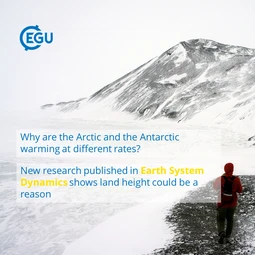Flat Antarctica – Land height could help explain why Antarctica is warming slower than the Arctic
Temperatures in the Arctic are increasing twice as fast as in the rest of the globe, while the Antarctic is warming at a much slower rate. A new study published in Earth System Dynamics, a journal of the European Geosciences Union, shows that land height could be a “game changer” when it comes to explaining why temperatures are rising at such different rates in the two regions.
Climate models and past-climate studies show that, as the Earth warms in response to an increase in greenhouse gases in the atmosphere, temperatures rise faster at the poles than in other parts of the planet. This is known as polar amplification. But this amplified warming is not the same at both poles.
“On average, warming for the entire Antarctic continent has been much slower than Arctic warming so far. Moreover, climate models suggest that, by the end of this century, Antarctica will have warmed less compared to the Arctic,” says Marc Salzmann, a researcher at the Institute for Meteorology, University of Leipzig in Germany.
A possible cause for the accelerated Arctic warming is the melting of the region’s sea ice, which reduces the icy, bright area that can reflect sunlight back out into space, resulting in more solar radiation being absorbed by the dark Arctic waters. Scientists believe this is an important contribution to warming in the region, but it’s not the only one.
Changes to the transport of heat by the Earth’s atmosphere and oceans to the poles have also been suggested as a possible contributor to the steep rise in Arctic temperatures. In addition, the cold temperatures and the way air is mixed close to the surface at the poles mean that the surface has to warm more to radiate additional heat back to space. These effects may not only lead to stronger warming at the north of our planet, but also at the south polar region.
“I wondered why some of the reasons to explain Arctic warming have not yet caused strongly amplified warming in all of Antarctica as well,” says Salzmann, the author of the Earth System Dynamics study. There had to be other factors at play.
“I thought that land height could be a game changer that might help explain why the Arctic has thus far warmed faster than Antarctica,” he says.
With an average elevation of about 2,500 m, Antarctica is the highest continent on Earth, much due to a thick layer of ice covering the bedrock. The continent also has high mountains, such as Mount Vinson, which rises almost 4,900 m above sea level.
To test his idea, Salzmann used a computer model of the Earth system to find out how the climate would react to a doubling of the atmospheric carbon-dioxide concentration. He also ran the same experiment in a flat-Antarctica world, where he artificially decreased the land height over the entire southern continent to one metre, a value similar to the surface height in the Arctic. This allowed him to compare how differently the Earth would react to an increase in greenhouse-gas concentrations in the atmosphere if Antarctica was assumed flat.
The experiments showed that, if Antarctica’s land height is reduced, temperatures in the region respond more strongly to a rise in the concentration of greenhouse gases over the continent. This contributes to an increase in Antarctic warming, which reduces the difference in polar amplification between the Arctic and the Antarctic.
The most significant factor, however, was a change in the way heat is transported in the atmosphere from the equator to the poles in the flat Antarctica world compared to the reference model. “Assuming a flat Antarctica allows for more transport of warm air from lower latitudes,” Salzmann explains. “This is consistent with the existing view that when the altitude of the ice is lowered, it becomes more prone to melting,” Salzmann explains.
In the long term, this could contribute to accelerate Antarctic warming in the real world. As the region warms due to increased greenhouse-gas emissions, ice melts, reducing Antarctica’s elevation over centuries or thousands of years. This, in turn, would contribute to even more warming.
###
Please mention the name of the publication (Earth System Dynamics) if reporting on this story and, if reporting online, include a link to the paper (http://www.earth-syst-dynam.net/8/323/2017/) or to the journal website (http://www.earth-system-dynamics.net).
More information
This research, by Marc Salzmann (Institute for Meteorology, Universität Leipzig, Germany), is presented in the paper ‘The polar amplification asymmetry: Role of antarctic surface height’ to appear in the EGU open access journal Earth System Dynamics on 18 May 2017.
Citation: Salzmann, M.: The polar amplification asymmetry: Role of antarctic surface height, Earth Syst. Dynam., doi:10.5194/esd-8-323-2017, 2017
The European Geosciences Union (EGU) is Europe’s premier geosciences union, dedicated to the pursuit of excellence in the Earth, planetary, and space sciences for the benefit of humanity, worldwide. It is a non-profit interdisciplinary learned association of scientists founded in 2002 with headquarters in Munich, Germany. The EGU has a current portfolio of 17 diverse scientific journals, which use an innovative open access format, and organises a number of topical meetings, and education and outreach activities. Its annual General Assembly is the largest and most prominent European geosciences event, attracting over 13,000 scientists from all over the world. The meeting’s sessions cover a wide range of topics, including volcanology, planetary exploration, the Earth’s internal structure and atmosphere, climate, energy, and resources. The EGU 2018 General Assembly is taking place in Vienna, Austria, from 8 to 13 April 2018. For information about meeting and press registration, please check http://media.egu.eu closer to the time of the meeting, or follow the EGU on Twitter and Facebook.
If you wish to receive our press releases via email, please use the Press Release Subscription Form at http://www.egu.eu/news/subscribe/. Subscribed journalists and other members of the media receive EGU press releases under embargo (if applicable) at least 24 hours in advance of public dissemination.
Earth System Dynamics (ESD) is an international scientific journal dedicated to the publication and public discussion of studies that take an interdisciplinary perspective of the functioning of the whole Earth system and global change. The overall behaviour of the Earth system is strongly shaped by the interactions among its various component systems, such as the atmosphere, cryosphere, hydrosphere, oceans, pedosphere, lithosphere, and the inner Earth, but also by life and human activity. ESD solicits contributions that investigate these various interactions and the underlying mechanisms, ways how these can be conceptualized, modelled, and quantified, predictions of the overall system behaviour to global changes, and the impacts for its habitability, humanity, and future Earth system management by human decision making.
Contact
Scientist
Marc Salzmann
Institute for Meteorology
University of Leipzig, Germany
Phone +49 341/97-32932
Email marc.salzmann@uni-leipzig.de
Press officers
Bárbara Ferreira
EGU Media and Communications Manager
Munich, Germany
Phone +49-89-2180-6703
Email media@egu.eu
X @EuroGeosciences
Universität Leipzig
University Communications
Phone +49 341 97-35021
Mobile +49 170 4548700
Email presse@uni-leipzig.de
Web: www.uni-leipzig.de/kommunikation
Links
- Scientific paper
- Journal – Earth System Dynamics
- Read this press release in simplified language, aimed at 7–13 year olds, on our Planet Press site




